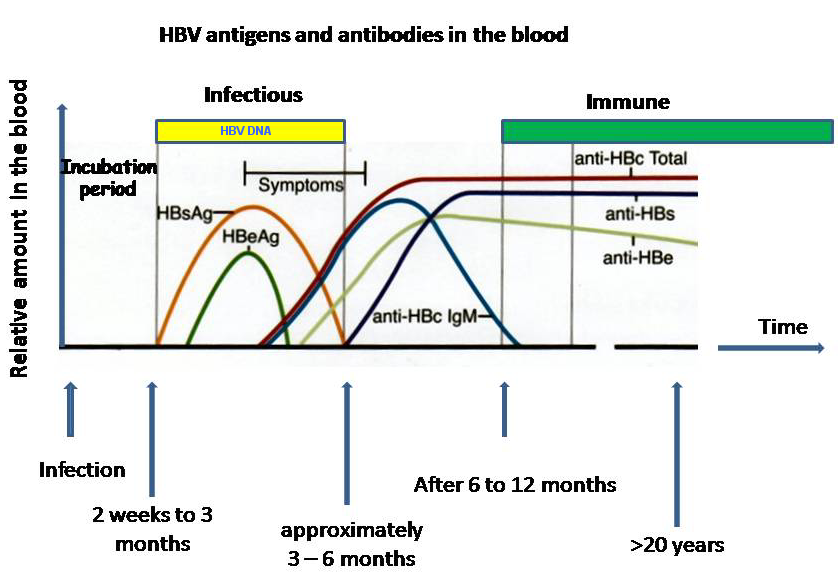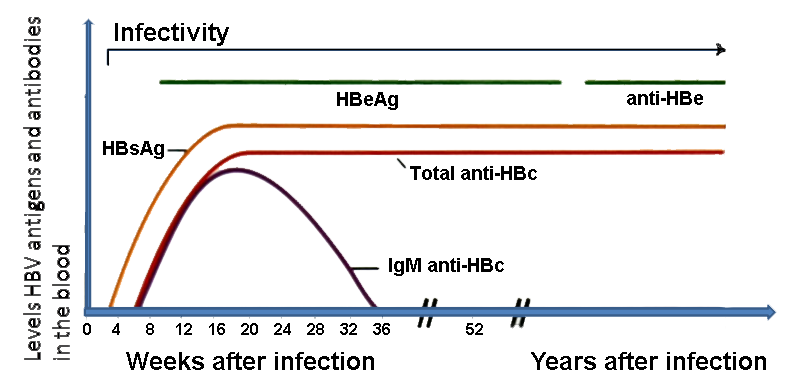Hepatitis B laboratory tests
|
Hepatitis B |
|
Diagnosis |
|
Treatment |
|
Case Studies |
|
Hepatitis B laboratory tests On the Web |
|
American Roentgen Ray Society Images of Hepatitis B laboratory tests |
|
Risk calculators and risk factors for Hepatitis B laboratory tests |
Editor-In-Chief: C. Michael Gibson, M.S., M.D. [1]; Associate Editor(s)-in-Chief: João André Alves Silva, M.D. [2], Sara Mehrsefat, M.D. [3]
Overview
The diagnosis of hepatitis is made by biochemical assessment of liver function. Initial laboratory evaluation usually reveals increased bilirubin levels; increased ALT, AST, and alkaline phosphatase; and decreased protein. Prothrombin time may be prolonged in cases of hepatocellular necrosis and hemoglobin may be low. Initial lymphopenia and neutropenia may be followed by lymphocytosis. Serologic markers such as Hepatitis B surface antigen (HBsAg) and anti-HBsAg; anti-HBc IgM and anti-HBc IgG; hepatitis B e antigen and anti-HBeAg confirm the diagnosis of hepatitis B. These levels fluctuate throughout the course of the disease.[1][2][3]
Laboratory Findings
The diagnosis of hepatitis is made by biochemical assessment of liver function. Initial laboratory evaluation should include:[1][4]
- Total and direct bilirubin (increased)
- Severe disease is often associated with persistent bilirubin levels >340 mol/L
- ALT and AST (increased)
- Alkaline phosphatase (normal or mildly elevated)
- Prothrombin time (prolonged from synthetic defect, caused by hepatocellular necrosis)
- Total protein (decreased)
- Globulin (mildly elevated)
- Complete blood count
- Initial lymphopenia and neutropenia, followed by relative lymphocytosis
- Low hemoglobin
A diagnosis is confirmed by the observation of specific antigens and/or antibodies in sera. Three clinically useful antigen-antibody systems have been identified for hepatitis B:
- Hepatitis B surface antigen (HBsAg) and antibody to HBsAg (anti-HBs)
- Antibody (anti-HBc IgM and anti-HBc IgG) to hepatitis B core antigen (HBcAg)
- Hepatitis B e antigen (HBeAg) and antibody to HBeAg (anti-HBe)
| Antigens | Description |
|---|---|
| HBsAg | Hepatitis B surface antigen is the earliest indicator of acute infection and is also indicative of chronic infection if its presence persists for more than 6 months. It is useful for the diagnosis of HBV infection and for screening of blood. Its specific antibody is anti-HBs. HBsAg indicates that the person is potentially infectious. |
| HBcAg | Hepatitis B core antigen is derived from the protein envelope that encloses the viral DNA, and it is not detectable in the bloodstream. When HBcAg peptides are expressed on the surface of hepatocytes, they induce an immune response that is crucial for killing infected cells. The HBcAg is a marker of the infectious viral material and it is the most accurate index of viral replication. Its specific antibody is anti-HBc. |
| HBeAg | Hepatitis B e antigen appearing during weeks 3 to 6 indicates an acute active infection at its most infectious period, and means that the patient is infectious. Persistence of this virological marker beyond 10 weeks shows progression to chronic infection and infectiousness. Continuous presence of anti-HBe indicates chronic or chronic active liver disease. HBeAg is not incorporated into virions, but is instead secreted into the serum. Mutant strains of HBV exist that replicate without producing HBeAg. HBeAg’s function is uncertain. Its specific antibody is anti-HBe. |
| HBxAg | Hepatitis B x antigen is detected in HBeAg positive blood in patients with both acute and chronic hepatitis. HBxAg is a transcriptional activator. It does not bind to DNA. Its specific antibody is anti-HBx. |
| HBV DNA | HBV DNA is detectable by PCR as soon as 1 week after initial infection, but the test is generally only performed for research purposes or to detect mutants that escape detection by current methods. |
| HBV DNA Polymerase | Tests for the presence of HBV DNA polymerase, detectable within 1 week of initial infection, are only performed for research purposes. |
| Antibodies | Description |
|---|---|
| Anti-HBs | This is the specific antibody to hepatitis B surface antigen. Its appearance 1 to 4 months after onset of symptoms indicates clinical recovery and subsequent immunity to HBV. Anti-HBs can neutralize HBV and provide protection against HBV infection. |
| Anti-HBc | This is the specific antibody to hepatitis B core antigen. Antibodies to HBc are of class IgM and IgG. They do not neutralize the virus. The presence of IgM identifies an early acute infection. In the absence of HBsAg and anti-HBs, it shows recent infection. IgG with no IgM may be present in chronic and resolved infections. Anti-HBc testing identifies all previously infected persons, including HBV carriers, but does not differentiate carriers and non-carriers. |
| Anti-HBe | This is the specific antibody to hepatitis B e antigen. During the acute stage of infection the seroconversion from e antigen to e antibody is prognostic for resolution of infection. Its presence in the patient’s blood along with anti-HBc and in the absence of HBsAg and anti-HBs indicates low contagiousness and convalescence. |
| Anti-HBx | This is the specific antibody to hepatitis B x antigen. It appears when other virological markers are becoming undetectable. |
Laboratory and Histology findings in Chronic Hepatitis B Infection
| Phase[3] | ALT | HBV DNA | HBeAg | Histology |
|---|---|---|---|---|
| Immune-tolerant | Normal | Elevated (typically >1 million IU/mL) | Positive | Minimal inflammation and fibrosis |
| Immune-active phase (HBeAg-positive) | Increased | Elevated (≥20,000 IU/mL) | Positive | Moderate-to-severe inflammation or fibrosis |
| Inactive CHB phase | Normal | Low or undetectable (<2,000 IU/mL) | Negative | Minimal necroinflammation and variable fibrosis |
| Immune reactivation phase (HBeAg-negative) | Increased | Elevated (≥2,000 IU/mL) | Negative | Moderate-to-severe inflammation or fibrosis |
Serological Markers
 |
 |
Serological markers may vary throughout the course of the disease:[1]
- Pre-S1 and pre-S2 antigens are present early in the incubation period. They are never detected in the absence of HBsAg.
- Hepatitis B virions, HBV DNA, DNA polymerase, and HBeAg are then also detected.
- The presence of HBeAg is associated with relatively high infectivity and severity of disease.
- Anti-HBc is the first antibody to appear. The observation of anti-HBc in serum indicates HBV infection, current or past.
- IgM anti-HBc is present in high titre during acute infection and usually disappears within 6 months, although it can persist in some cases of chronic hepatitis. This test may therefore reliably diagnose acute HBV infection.
- IgG anti-HBc generally remains detectable for a lifetime.
- Anti-HBe appears after anti-HBc and its presence correlates to a decreased infectivity. Anti-HBe replaces HBeAg in the resolution of the disease.
- Anti-HBs replaces HBsAg as the acute HBV infection is resolving. Anti-HBs generally persists for a lifetime in over 80% of patients and indicates immunity. Acute hepatitis patients who maintain a constant serum HBsAg concentration, or whose serum HBeAg persists 8 to 10 weeks after symptoms have resolved, are likely to become carriers and at risk of developing chronic liver disease.
Diagnostic Studies
The following studies are used to examine pathological specimens for the presence of HBV-associated antigens or particles. They provide information about the relationship between HBV DNA replication and HBV gene expression.
- Immunofluorescence studies
- In situ hybridization
- Immunohistochemistry
- Thin-section electron microscopy
PCR
More recently, PCR tests have been developed to detect and measure the amount of viral nucleic acid in clinical specimens. These tests are called viral loads and are used to assess a person's infection status and to monitor treatment.[5]
Recommendations for Monitoring Patients with Chronic HBV Infection: AASLD Practice Guidelines[3]
| Class I |
| "1. HBeAg-positive and HBeAg-negative patients who meet criteria for chronic hepatitis B should be evaluated for treatment." |
| Class III |
"2. HBeAg-positive patients:
|
| Class III |
"3. HBeAg-negative patients:
|
References
- ↑ 1.0 1.1 1.2 World Health Organization, Guidelines for the Prevention, Care, and Treatment of persons with chronic Hepatitis B Infection. (March 2015). http://apps.who.int/iris/bitstream/10665/154590/1/9789241549059_eng.pdf Accessed on October 4th, 2016
- ↑ Center for Disease Control and Prevention. Hepatitis B Epidemiology and Prevention of Vaccine-Preventable Diseases 2012.http://www.cdc.gov/vaccines/pubs/pinkbook/hepb.html
- ↑ 3.0 3.1 3.2 AASLD guidelines for treatment of chronic hepatitis B. Hepatology (2016)http://onlinelibrary.wiley.com/doi/10.1002/hep.28156/full Accessed on October 10th, 2016
- ↑ Fields, Bernard (2007). Fields virology. Philadelphia: Wolters Kluwer Health/Lippincott Williams & Wilkins. ISBN 0781760607.
- ↑ Zoulim F (2006). "New nucleic acid diagnostic tests in viral hepatitis". Semin. Liver Dis. 26 (4): 309–17. doi:10.1055/s-2006-951602. PMID 17051445.